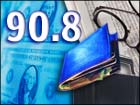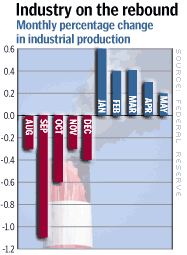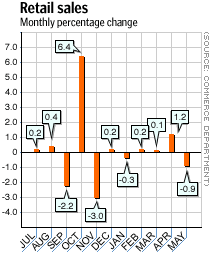
NEW YORK (CNN/Money) -
The closely watched University of Michigan consumer sentiment index fell sharply in June, according to published reports Friday, surprising economists and pointing to a possibly sluggish recovery in the broader U.S. economy.
Coming a day after the government reported a sharp drop in retail sales in May, the news raised more questions about the ability of consumers to bear up under falling stock prices, terror threats and unemployment.
The University of Michigan's consumer sentiment index fell to 90.8 from 96.9 in May, according to a Reuters report. Economists surveyed by Briefing.com expected the index to slip to 96.6.
In the survey, available only to paying subscribers, the index of consumers' expectations fell to 86.2 from 92.7 in May while the measure of consumers' feeling about current economic conditions fell to 97.9 from 103.5, according to Reuters.
"What consumers are reacting to is more of the non-economic situation than the economic situation," said Joel Naroff, president and chief economist of Naroff Economic Advisors in Holland, Pa. "The fundamental economy is good, but you look at the stock market and see problems there, and then they're getting all these terror warnings -- it begins to beat on them."

Separately, the Federal Reserve said production rose 0.2 percent last month after a revised 0.3 percent gain in April. The Fed also said capacity utilization rose to 75.5 percent in May from a revised 75.4 percent in April.
Economists surveyed by Briefing.com had forecast capacity use at 75.7 percent and an industrial production increase of 0.4 percent.
"This was pretty modest, consistent with the gradual recovery we're seeing overall," said Scott Brown, chief economist at Raymond James & Associates. "It will be some time before the excesses are cleared up and the economy can get back to running ahead."
And the Commerce Department said business inventories fell 0.2 percent to $1.11 trillion in April after falling a revised 0.4 percent in March. April's decline matched the expectations of economists surveyed by Briefing.com.
Sales rose 1.8 percent, the biggest gain since October 2001, after rising 0.4 percent in March. After so many months of inventory reduction, the ratio of inventory to sales fell to just 1.35, the lowest ratio on record.
U.S. stock prices fell in early trading, while Treasury bond prices rose.
Inventory reduction means businesses will have to produce more goods once demand picks up. More production would likely mean more jobs, important to the outlook for consumer spending, which fuels two-thirds of the overall U.S. economy.
But the key is a pick-up in demand. Consumers have shouldered the load during the downturn, but businesses will need to start spending for the recovery to gain strength. With factories running at just 75.5 percent of capacity, a good deal of production equipment is sitting idle, meaning businesses don't have much incentive to buy more equipment.

And businesses are operating more efficiently, too, getting more production out of fewer workers, meaning they have little incentive to add new jobs. The unemployment rate has been hovering around 5.8 percent -- the highest level since 1994 -- for six months and could stay at that level for some time.
Meanwhile, consumers have mounting debt, are earning less and are starting to sock away more in savings. Most economists said May retail sales were lower mainly because of cold weather and a payback for strong sales in April, but other analysts pointed out that discount retailers did pretty well, a hint that consumers were more worried about prices than they were about weather.
Consumer spending makes up two-thirds of the U.S. economy, and its resilience -- thanks in part to 11 interest-rate cuts by the Federal Reserve in 2001, which made borrowing cheaper -- made a recession that began in March 2001 one of the shortest and mildest in history.
But Fed Chairman Alan Greenspan has warned that strong spending during the downturn basically stole strength from the recovery, so that consumer spending might need help bearing the load this year.
| |
 Related links
Related links
| |
| | |
| | |
|
"We're coming off 6 percent consumer spending growth in the fourth quarter, and that's going to moderate," said Anthony Chan, chief economist at Banc One Investment Advisors. "It's not going to collapse, but see we spending in the neighborhood of 2 to 3 percent for the rest of the year."
"Given the signs of recovery in the manufacturing sector, that won't bring the economy to its knees, but it will ensure that this will be a moderate rather than robust recovery," Chan added.

|

